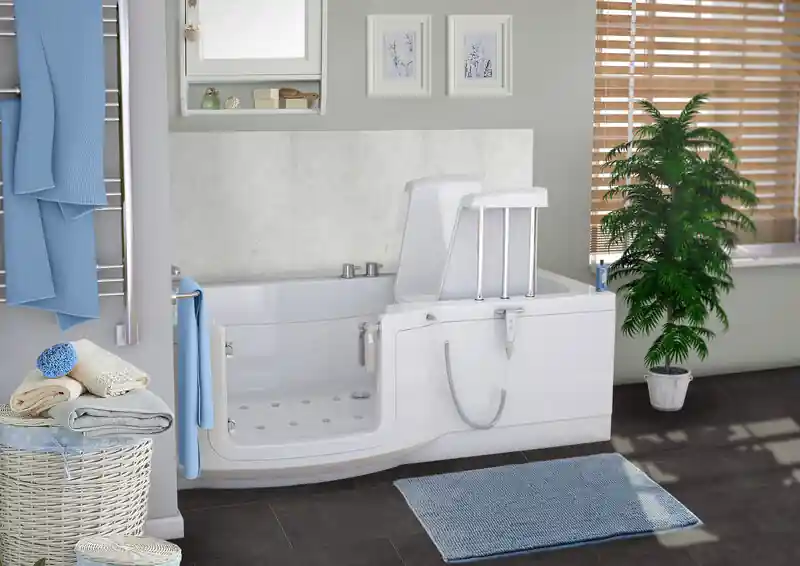
by Jon Pearce | 30th Sep, 2023 | Blog, Walk-in baths

Everyone knows how to work a regular bathtub or shower. It’s as straightforward as turning on the tap, putting the plugin, waiting for it to fill up before adding your favourite lotions and potions and climbing over the side, settling in and relaxing.
However, problems can arise when people with limited mobility have trouble manoeuvring over the bathtub wall. If you experience this, a regular bathtub or shower can be a dangerous part of your bathroom, causing slips, falls and injuries if you’re not careful.
But what’s the solution? A sure way to fix these issues and make your bathing experience a safer, more manageable one is to invest in a walk-in bath. But we often get asked how these walk-in baths work and whether they’re right for you. So, let’s get right to it and investigate what is a walk-in bath, the different types, and how they work so you’re completely aware of what you’d be signing up for if you got one.
Request a Free Brochure
Simply fill out a quick form and see how we can transform the way you bathe.
Request Free Brochure
- What is a walk-in bath?
- Different types of walk-in baths
- Step-by-step guide to using them
- Why you might need one
- The cost of walk-in baths
What is a walk-in bath?
A walk-in bath is similar to a regular bathtub in many ways. These clever inventions are essentially a tub with a watertight door that allows the user to step into the bath rather than over the bath. The door can then be closed before filling the bathtub with water. When the individual has finished bathing, the water can be drained, the door opens, and they can safely exit.
As an investment piece for your bathroom, it’s only natural that you will have some questions, such as what are the advantages in comparison to a regular bath? Before we discuss these points, let’s look at the different available options.
The different types of walk-in baths
There are many options available when it comes to choosing the right walk-in bath. The most common you will likely come across are:
Before choosing your walk-in bath, it’s worth exploring these options in more depth to find the one that’s right for your needs and bathroom space.
A step-by-step guide to using your walk-in bath
1. Open the door and step inside
Some walk-in baths will have inward-swinging doors while others have outward-swinging doors. The choice is entirely up to you and what suits your preferences and bathroom space.
2. Close the door and run your bath
Once you’re comfortably sat, close the door to your walk-in bath to seal the bathtub before turning the tap on. You’ll have to sit inside the bath while it fills up, but this shouldn’t take too long.
Even better, our baths have the option to include a bath filler. Rather than finding the right temperature by twisting your taps, you can use the bath filler to automatically fill your bath at the right temperature. Once you’ve chosen your temperature, it won’t change until you choose to change it, thanks to the safety control.
3. Sit back, relax and enjoy
Once you’re happy with the temperature and level of water, turn the tap off and sink into your luxurious bathing experience. Depending on what you’ve opted for, you may be able to enjoy some additional features too. For example, here at Mobility Plus, our walk-in baths provide the options to have:
- Easy temperature control
- Support hand bars
- Stylish and modern designs
- Low entry doors
- Spatherapy: This is a series of jets used to pump out bubbles of clean air, creating a gentle massaging effect that relaxes muscles and can help those suffering from aches and pains.
- Chromotherapy: This is a light-based therapy that helps the mind and body to relax. Light waves are a form of energy used to promote healing within the body.
- Drain the water: Once finished, it’s time to drain the water, open your sealed door and step out of your walk-in bath.
Why do you need a walk-in bath?
As you get older, you may start experiencing reduced mobility, or you may already be experiencing this due to an illness or injury. When this occurs, the everyday task of getting in and out of the bathtub becomes difficult and all the more dangerous. However, this doesn’t mean you should miss out on the relaxation of soaking in a warm bath.
There are many advantages to a walk-in bath that a regular bathtub cannot provide, such as:
No lowering into the bath
A walk-in bath has watertight doors that allow you to get in and out of it by walking in and out. This avoids having to climb over the side and lower yourself, which you may struggle to do with limited mobility. Doing this can also increase the risk of slipping.
Different sizes for different needs
Walk-in baths are often compact by design and can be made so that the user can sit up while bathing. However, walk-in baths also reflect the more traditional bathtub design. These are full-length, allowing you to lie down and submerge more of your body while bathing.
A comfortable and easy bathing experience
Walk-in baths are designed to create a much easier, more enjoyable and comfortable bathing experience, particularly for those with mobility issues or the elderly. For example, the low point of entry means that you can enter and exit the bathtub with ease, while the hand grab rails provide another point of contact to make the experience more manageable.
All features in one package
Walk-in bathtubs offer a range of features in one model, saving you the hassle of having to purchase each safety feature separately. Rather than buying modifications such as handrails, temperature controls, safety valves and non-slip flooring, you get it all in one model when purchasing a walk-in bath. This makes buying and installing your bathtub easier without having to make modifications along the way.
Deeper water
With a walk-in tub, you don’t need to step over the side. This means walk-in tubs can provide a deeper water depth in comparison to traditional bathtubs. In some cases, walk-in tubs can provide up to four feet of water, making for a much more comfortable bathing experience while still being securely seated. Many walk-in baths often have extra functionality, such as hydrotherapy jets and heated seats. The water is much deeper, so you can enjoy these features while being comfortably sat.
Make hydrotherapy part of your everyday
There are many benefits of using warm water daily. For example, to reduce aches and pains, soothe any sore areas caused by arthritis or speed up the healing process of any injuries. As well as this, baths are a well-known place to switch off from the outside world and relax. By relaxing your mind, you can also relax your body, making your walk-in bathing experience one you’ll look forward to every day.
What’s the cost?
While a brilliant investment, the cost of a walk-in bath can vary depending on the features that you want to include as part of the package. Some of the most common factors that can affect pricing include:
- The extra modifications you choose for your walk-in bath
- The style of bathtub that will suit your bathroom space
- Whether you want to include any more luxurious additions such as spatherapy or chromotherapy
Many useful additions are designed specifically for those with limited mobility or to create a disability-friendly bathroom space.
Take your pick
As the UK’s leading supplier of walk-in baths, we can help you create a safer, more enjoyable and relaxing bathing experience in the comfort of your own home.
If you want to find out more about how walk-in baths work, or if walk-in showers or wet rooms are more to your liking, please don’t hesitate to get in touch with our team.
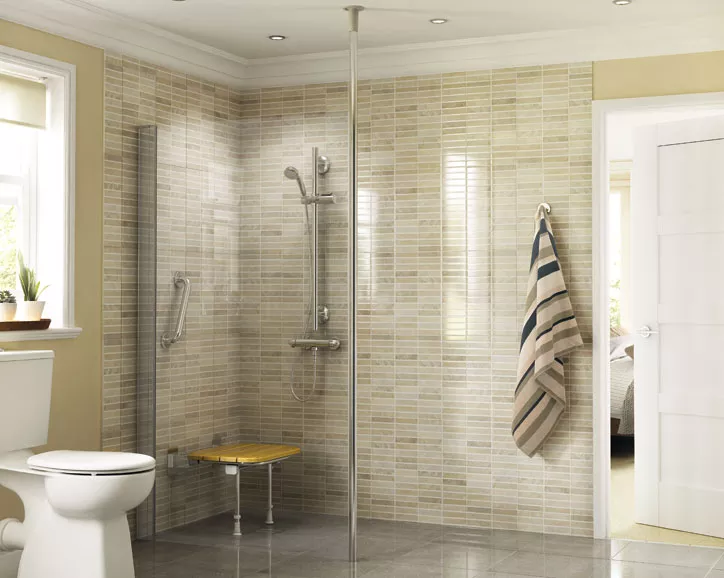
by Jon Pearce | 27th Sep, 2023 | Walk-in showers

Everyone deserves to feel safe when showering. But the fear of slipping, pain, or mobility issues can make showers an ordeal rather than a time to relax. That doesn’t have to be the case.
We want you to feel comfortable, which is why we’ve collated a list of walk-in showers with seats or benches. Read on for the advantages and disadvantages of different shower seats and find the best one to suit your showering needs.
Looking to make your shower safer?
Simply fill out a quick form and see how we can transform the way you bathe.
Request Free Brochure
- Standard Shower Stool
- Standard Shower Chair
- Folding or Hanging Shower Chair
- Rolling Shower Chair
- Transfer Bench
- The Best Walk-in Shower or Bench for You
- Enjoy Your Shower With a Walk-in Shower Seat or Bench
1. Standard Shower Stool
A shower stool is a free-standing stool you place in the shower. They come in different sizes and allow you to rest while washing.
Benefits of a Shower Stool
- Free-standing – A shower stool is not fixed on the shower wall, so you can shift it according to your preferences.
- Suitable for balance issues – They keep you stable if you struggle to balance in the shower or are conscious of slipping.
- Budget-friendly – Stools are ideal if you’re on a budget or don’t want to invest too much into a shower seat.
- Ideal for mobility restrictions – They reduce the distance you need to move, minimising pain when washing.
- Gives you a resting place – Perhaps you enjoy standing to shower but get tired after a few minutes. A shower stool allows you to take breaks as regularly as you want.
Disadvantages of a Shower Stool
- Less stable than fixed shower seats – It may shift because a stool is not attached to the wall or floor. However, they do have rubber soles to increase stability.
- Lack of adjustments – Shower stools are typically set at a certain height and don’t always have adjustment settings. Therefore, you may struggle to sit comfortably if the stool is too low or high.
- Not suitable for everyone – A standard shower stool is usually one-size-fits-all, so they don’t cater to every body type, mobility issues or age.
- No back support – Unlike shower chairs, a stool has no back. So there are better options than stools if you need comfort and stability for your spine.
2. Standard Shower Chair
A standard shower chair is similar to a stool but with a back. Some come with armrests or stability support, and others do not.
Benefits of a Shower Chair
- Moveable – You can move shower chairs to different positions and take them out of your walk-in shower to use in another area of your bathroom.
- Back support – If sitting upright on a stool is too difficult, a chair will ease the strain on your spine.
- Provides stability – A shower chair supports your posture and balance, so you don’t need to worry about falling.
- Helps reduce pain from mobility restrictions – Standing to shower or maintaining your posture on a stool may cause pain. However, a shower chair gives you the independence to sit in comfort.
- Armrest support – The armrests on shower chairs are helpful to lean on when lowering or lifting yourself from the chair.
Disadvantages of a Shower Chair
- Restricted movement – A fixed shower chair’s back and arms may limit your movements and ability to shower in your preferred position.
- Not always suitable if you struggle to sit from standing – If you have mobility issues that make it painful or challenging to sit down or stand up, you may prefer a seat that caters to your height and movement restrictions. However, some shower chairs offer adjustable seating.
- Less stable than fixed seating – Because shower chairs are free-standing, they may tip if you lean on them too heavily.
- Take up space – Shower chairs can be bulky and take up more surface area than a shower stool.
3. Folding or Hanging Shower Chair
A folding or hanging shower chair fixes onto the shower wall or is hooked over a grab rail. They come in many different shapes and designs, providing rest and stability when showering.
Benefits of a Folding or Hanging Shower Chair
- Stable – Because a folding or hanging chair uses a permanent fixture, they do not tip or move when in use.
- Space-saving – Folding shower chairs are a good option if you have a small walk-in shower or you don’t like the look of bulky shower chairs.
- Useful if you don’t want to sit directly under the shower – A folding or hanging chair allows you to sit and wash body parts without being under running water.
- Can place to your ideal height – During installation, you can place a folding or hanging chair at the best height for you.
Disadvantages of a Folding or Hanging Shower Chair
- Permanent – A hanging or folding shower chair requires a fixture on your shower wall. Therefore, they may not be suitable if you rent or plan to sell your house.
- No armrests – The lack of armrests can make the chair difficult for anyone who needs support getting up and down.
4. Rolling Shower Chair
A rolling shower chair has wheels on the bottom so you can roll the chair in and out of a walk-in shower. Some rolling shower chairs have adjustable seats and armrests.
Benefits of a Rolling Shower Chair
- Ideal for low mobility – Rolling chairs for the shower for the disabled work well if the individual has little to no mobility.
- Provides independence – For people who use wheelchairs, rolling shower chairs allow them to go in and out of a walk-in shower independently.
- Easy transition – There is no need to get up from one place and move into the shower. Instead, the chair can roll straight in.
Disadvantages of a Rolling Shower Chair
- Less stable than a fixture – Although the wheels provide easy transition, it is less stable than a fixed shower seat.
- May have limited adjustments – Depending on the quality of the rolling shower chair, it may have few adjustments for comfort and practicality.
5. Transfer Bench
A transfer bench is long and usually has an inbuilt chair on one end. Half of the bench stands outside the walk-in shower, while the other side extends into the shower.
Benefits of a Transfer Bench
- Less risk of slipping – You will not have to step onto the shower floor but can sit outside and slide into the shower.
- Easy transition – A person can sit on the outside and move across into the shower without having to get up or down.
- Simple to use – You can place transfer benches directly into the walk-in shower without fixing them to the shower wall.
Disadvantages of a Transfer Bench
- No grab rails – Although some transfer benches have a grab rail at one end, they do not have them all the way across.
- Needs some mobility – A person will need to hold themselves and move across the bench into the walk-in shower.
- Takes up space – Transfer benches take up more space than stools and folding chairs, so they are unsuitable for small bathrooms.
The Best Walk-in Shower or Bench for You
Choosing a shower seat or bench that fits your criteria and independent needs is essential. Below is the complete list of walk-in shower seats that suit different mobility, pain or disability challenges.
Shower Stool
Best if you have mild mobility or balance issues and want a non-permanent resting place while showering.
Shower Chair
Best if you require back support and armrests to help you sit or stand. You can also use a shower chair for the elderly if the person still has mobility but gets tired easily.
Folding or Hanging Shower Chair
Best if you have a small shower or don’t want a shower chair to take up space. They’re good if you struggle with mild pain and mobility or have balance restrictions.
Rolling Shower Chair
Best for little to no mobility or for anyone who finds it painful to get up and down. A rolling shower chair is also handy for carers to easily transfer you in and out of the shower.
Transfer Bench
Best for someone who struggles with balance and would prefer not to step onto the shower floor. Also useful if you have restricted mobility going from standing to sitting and vice versa.
Enjoy Your Shower With a Walk-in Shower Seat or Bench
Showers don’t have to be painful or difficult to manage with the right walk-in shower seat or bench. Select one that suits your needs so you can comfortably enjoy every shower.
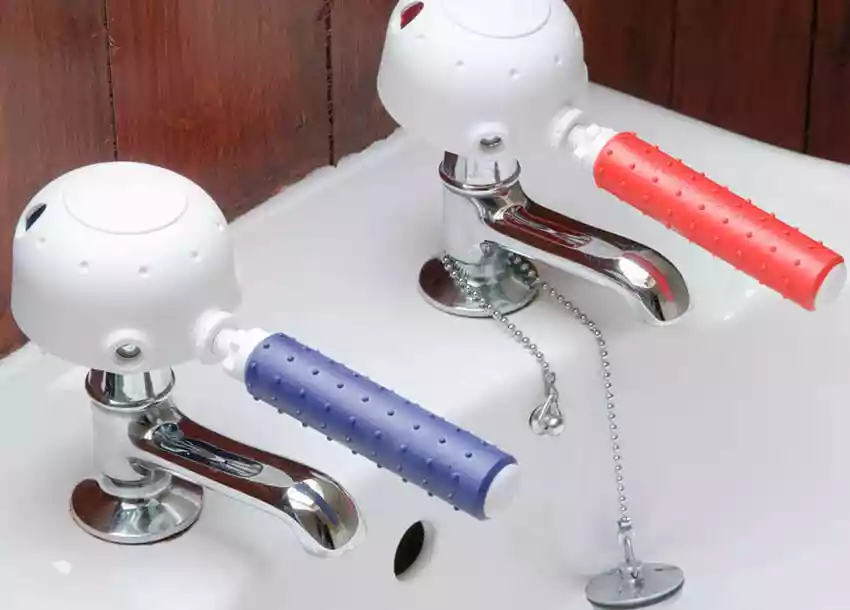
by Jon Pearce | 21st Sep, 2023 | Accessibility

Far from being a sign that you are losing your independence, disabled washing aids in fact, can mean quite the opposite. For people living with a disability, the simple task of washing can be a challenge, yet feeling safe while you bathe is very important.
Daily living aids, including disabled washing aids for disability bathrooms, can help people become more confident at being alone, enhance independence and simply make life easier.
Fortunately, there are several disabled washing aids available to those who have reduced mobility and dexterity. They provide physical support and peace of mind, which makes these washing aids a small adjustment with life-changing effects.
To help you choose, we have put together a guide to our top washing aids for people with disabilities.
Are you affected by mobility issues when bathing?
Simply fill out a quick form and see how we can transform the way you bathe.
Request Free Brochure
- Non-Slip Bath Discs
- Hair Washing Aids
- Shower or Bath Stools
- Long handled washing devices
- Tap Turners
- Bath Lifts
- Grab Rails
- Walk-in baths or showers
1. Non-Slip Bath Discs
You have probably heard of a bathmat, but bath discs go one step further. Non-slip bath discs usually come as individual adhesive circles on a roll, for ease of application and use.
They provide a convenient, effective, and stylish way of applying a non-slip surface to your bath without ruining the aesthetic of your home décor. Unlike a normal bath mat, which has the prospect of moving or causing you to feel unstable, once stuck down, non-slip bath discs remain in place.
These discs are also comfortable, non-abrasive and will not irritate your bare skin. They’re also super hygienic. You clean them alongside your bath and due to the lack of extreme textures, they will not harbor bacteria like a regular bath mat, making cleaning quick and easy.
2. Hair Washing Aids
There’s nothing better than the feeling of freshly washed hair and fortunately there are some great hair-washing aids available. Washing trays and portable basins can make the difficult task of washing your hair whilst in your wheelchair much more pleasant.
The trays have raised edges allowing the user to have their hair washed by a carer or loved one whilst lying down. They also provide great neck support, so you feel comfortable yet pampered.
If you need a little extra support washing your hair independently, then a long-handled hair washer could be the game-changing solution you are looking for. Helping to increase your reach and massage shampoo into your scalp, this hair-washing aid allows the user to wash their hair with greater ease.
3. Shower or Bath Stools
When you live with physical limitations, daily tasks like getting in and out of a bath or standing upright and washing yourself in the shower might be difficult to do. Shower or bath stools are a great disabled washing aid to use as they can support the body whilst conserving your energy when you wash.
When you use a shower stool or bath stool, it increases your safety by providing you with a secure area within a potentially slippery zone, limiting your chance of falling.
Whether you use a wheelchair or find excessive movement tiring or difficult, then bath and shower stools offer a useful and simple solution. A little independence can go a long way and this is especially true if you’re in pain.
You can finally relax in the bath or shower and let the warm water ease your joints and muscles with a tiny addition to your bathroom.
4. Long handled washing devices
Another simple and cheap addition to your independence toolkit has to be a long-handled washing device. Designed to help people with flexibility issues to wash with minimum strain and maximum ease, you can find a range of long-handled washing aids including sponges and scrubbing brushes.
A long-handled back sponge is particularly useful for the elderly or for people who find it difficult to reach over their shoulders, however there are also aids available to help with hair washing too.
Using one couldn’t be simpler. It helps you clean your body without the need for bending and stretching, making it ideal for those suffering from joint pain and stiffness.
5. Tap Turners
Painful or weak wrists caused by conditions like arthritis and other mobility issues can make gripping and turning taps a challenge, and let’s face it, we need to turn taps several times a day!
Tap turners offer helpful assistance by attaching to the tap and providing a secure grip, meaning you can turn them on and off with ease. Although there are many different styles of tap turners, most feature comfort grips to further enhance the ease of use.
This accessible aid is also kind to pockets, making a difference to your daily life for just a small price between £5 to £20. There is also no formal installation required which means you can buy and fit them yourself with immediate benefit.
6. Bath Lifts
There’s nothing quite like relaxing in a warm bath, especially when you experience chronic pain and aching muscles and joints. Add the stress-relieving benefits, then it’s not surprising many people with disabilities like to use a bath as part of their weekly routine. Bath lifts provide a safe option for bathing for those with limited mobility.
Available in a range of designs and sizes, bath lifts are typically battery-operated using a remote for the person in control to gently lower and raise you in and out of the bath.
They promote a great sense of independence and access to bathing and personal care, which is so important to so many with disabilities, especially if they have previously relied on a loved one or carer.
7. Grab Rails
One of the easiest and most helpful disabled washing aids are suction grab rails. Designed to fix easily onto a tiled wall, grab rails are a simple solution to provide support when bathing or showering.
They also make a great travel companion as their suction fixture means you can easily take them to a different location or to simply move them around your own home.
Available in a range of sizes, shapes and colours, these bathing aids are a cheap and easy option for those looking to prevent falls and provide extra confidence and independence when washing. Make sure you are careful when fitting them into their position, however. Test them before use and be extra careful if they have been in the same position for a long time.
8. Walk-in baths or showers
You may love a refreshing shower or the pain-relieving benefits of a warm bath, but whichever is your preferred method of washing, there is a more permanent solution to make it accessible and safe.
Walk-in showers or wet rooms come with supportive features such as fold-away seats, built-in grab rails, easy temperature control systems and non-trip shower trays. This low or no-threshold tray makes getting in and out of the shower much safer and easier. These options are growing in popularity because they are very accommodating for the different sizes of bathrooms you find, whether they be very small or large, since they can be completely fitted to the space.
Walk-in baths are specifically designed to make the bathing experience much better for people with disabilities or low mobility. They offer an easy entry point with a low threshold as well as grab rails and seats for bathing. Walk-in baths often have non-slip flooring already in place to minimise the risk of slipping, making having a bath much more manageable and relaxing. Many designs are also very stylish which can add to the aesthetic of your bathroom rather than feel too clinical.
Whether you opt for quick fixes or more permanent changes to your bathroom, finding a way to wash and bathe where you feel confident, comfortable and safe that suits your personal needs and taste is one of the best routes to gaining your independence.

by mobilityplus | 9th Sep, 2023 | dementia, Disabillities
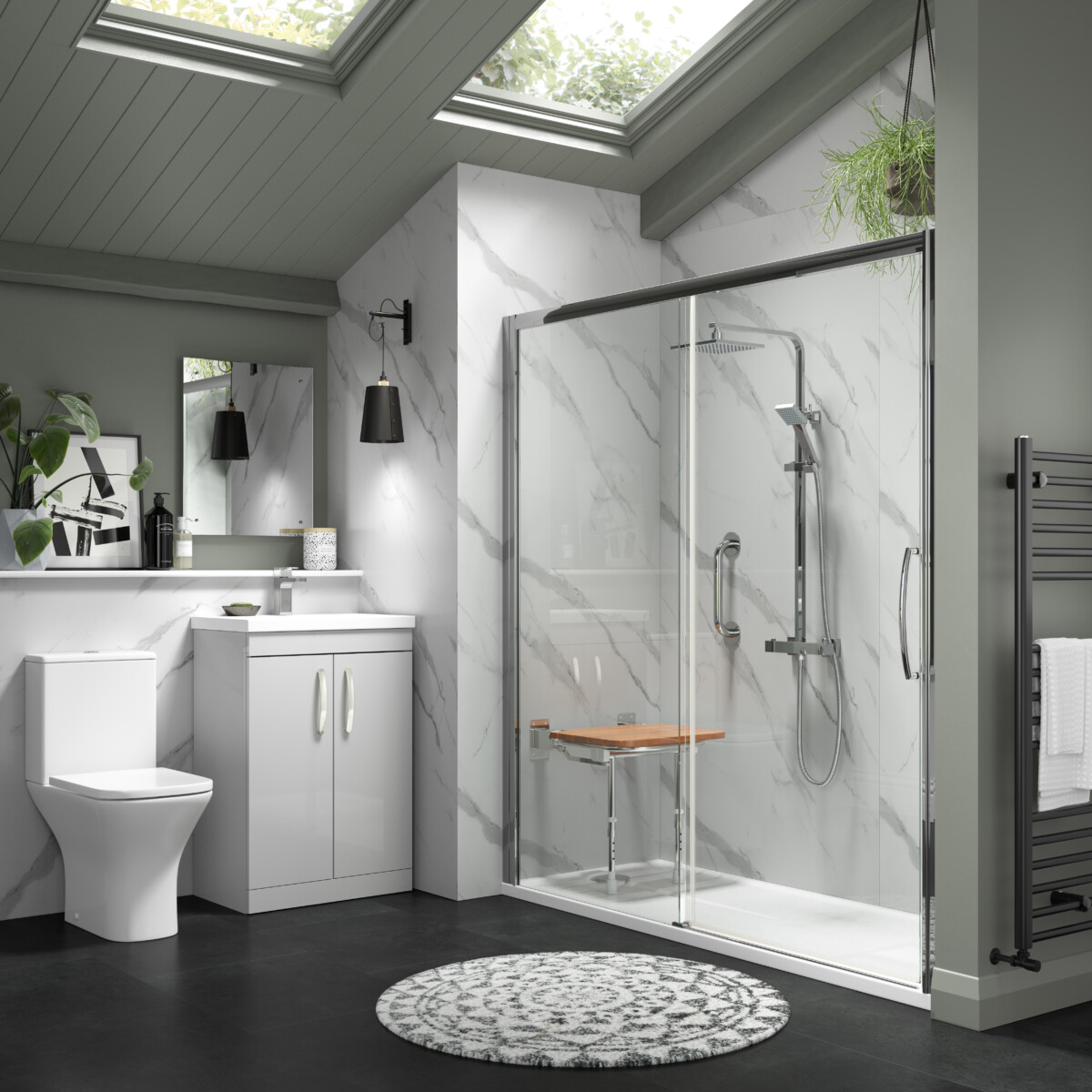
If you are disabled or have limited mobility, you may find that getting in and out of the shower can be difficult to manage sometimes. But there are options you can consider to make showering easier to manage in a disability bathroom. Level access showers and wet rooms are the safest and most practical showering solution for people with mobility restrictions, whether for severe or minor disabilities.
Still not sure whether this is the right option for you? Here are 3 things to know about mobility showers.
- How will a level access wet room or walk-in shower help me?
- Can I change some aspects of the wet room?
- What if I need extra mobility during showering or bathing?
- Can I customise my walk-in shower or bath?
Request a Free Brochure
Simply fill out a quick form and see how we can transform the way you bathe.
Request Free Brochure
1. How will a level access wet room or walk-in shower help me?
A level access shower or wet room is exactly how it sounds. Instead of having a shower tray that the water flows into, the entire floor becomes waterproofed and given adequate drainage.
This means that there is no longer a lip or edge of a shower tray to navigate, which can be especially difficult for those who have limited mobility, or need to use a wheelchair.
The ease of access, wide opening entry, and option for assisted bathing makes it the perfect solution in settings such as care homes, hospitals and they can even be built in your own home. With a built-in slip-resistant shower floor, you are able to get in and out with your wheelchair, zimmer frame, or walk straight in with confidence and peace of mind. Wet rooms will usually have other features making them safer, like grab rails, fold-down seats and easy-to-use temperature controls.
2. Can I change some aspects of the wet room?
There are also many shower screen options available to suit all of your showering needs whether you need disabled shower access for assisted showering, whereby a half height panel screen would be the most suitable for the ease and benefit of a carer, plus the water stays within the shower area at all times.https://www.mobility-plus.co.uk/walk-in-showers/the-coniston/half-height-panel-bifold-doors/
Alternatively, if you are able to shower independently, then a full height open panel screen might be your preferred option so that you can get in and out with your mobility equipment easily.
3. What if I need extra mobility during showering or bathing?
As already mentioned, there are also options for extra mobility assistance with shower accessories such as grab rails, shower seats, different size doors and screen options to suit all mobility requirements. All these features improve the overall experience for disabled persons or those with limited mobility, making wet rooms an especially useful bathing area.
The Mobility-Plus walk-in showers, walk-in baths, easy access wet rooms and shower pods not only offer a completely practical mobility solution for disabled bathing but they are also the most stylish and modern bathrooms currently in the mobility market. Level access showers are the way to go if you have a disability both for practicality and safety.
If you want a modern style as well then our Mobility Plus level access wet room showers are the perfect solution for you.
4. Can I customise my walk-in shower or bath?
Walk-in baths, walk-in showers and even wet rooms are made completely bespoke for you and your bathroom space. For example, detachable grab rails can be added to the walk-in shower or bath units and the walls of wet rooms, if that’s a feature that you would like. The installation process is completely seamless and we work with you to find the solution that you want.
For walk-in showers and wet rooms, you also have the option of adding a shower seat, as some people who have mobility issues may not be able to stand up whilst showering.
Still wondering if a walk-in shower or level-access wet room is for you? Why not order a free brochure or talk to one of our lovely contact team to ensure that a walk-in shower is right for you and your lifestyle.
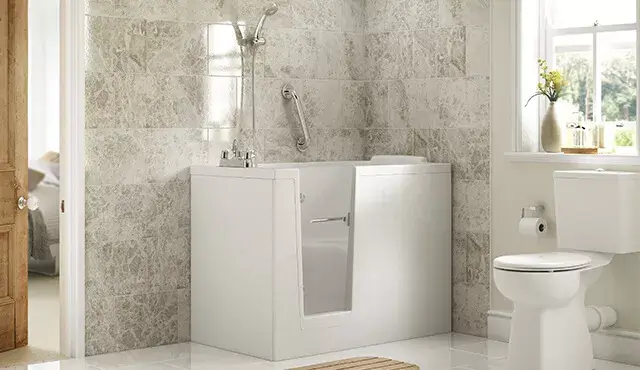
by Jon Pearce | 11th Aug, 2023 | Walk-in baths

Mobility-style baths, or walk-in baths, are an excellent alternative to traditional baths for those with mobility difficulties. These baths allow you to bathe in the comfort of your home without support and enjoy a safe bathing experience without putting strain and stress on your body.
In this article, we’ll uncover the safety features built into mobility-style baths and what to expect if you’re looking to purchase one.
Request a Free Brochure
Simply fill out a quick form and see how we can transform the way you bathe.
Request Free Brochure
- Features of mobility-style baths for safety
- Types of grab rails for walk-in baths
- Different grab rail styles
- Slip-resistant mats in walk-in baths
- Multi use shower head
- Low doors
- Thermostatic bath fillers
- Quick draining
- Built-in seat
- Sanitary coating
- How does a walk-in bath aid with bathroom safety?
Features of mobility-style baths for safety
Sit-in baths are designed for those with mobility issues, and below is a list of the safety features that help with this.
Types of grab rails for walk-in baths
Several variations of grab rails are incorporated in walk-in baths to make this type of mobility bath more accessible to everyone. Below are the types of grab rails available.
1. Straight Horizontal
These bathroom grab rails are installed where seating and standing is required, such as getting on and off a seat for a bath routine. These help push you down and support you when getting up off the seat.
2. Straight Vertical
Straight vertical grab rails are suitable for when a pulling movement is required. In particular, they’re great for assisting with you entering and exiting the bath and can aid with all types of weights.
3. Angled
Angled bathroom grab rails combine the benefits of vertical and horizontal benefits and help with either pulling or pushing movements. They’re typically found in baths, as they assist with various movements rather than having to have multiple grab rails installed.
4. Folding
If you have limited space in your bathroom, folding grab rails might be an excellent choice. They’re stylish and versatile, as they fold out when required and fold flat against a wall when not in use, helping create more space in a bathroom.
Different Grab Rail Styles
Aside from the various types of grab rails, there are various styles of grab rails available to complement your bathroom and suit your design choices. These can also aid with safety by improving grip and visibility.
1. High Contrast
Bathroom rails are available in bright colours to improve visibility for those with a visual impairment.
2. Slip Resistant
Hands rails are designed for safety, but the addition of a slip-resistant, gripped surface can further improve safety. This is something to consider for baths where there’s water present. Though you might want to consider that the surface will be rougher if you have sensitive hands.
3. Plastic Finish
A plastic-finish grab rail is more affordable than the alternative styles. While they might be more clinical-looking, they’re hardwearing and warm to the touch, which makes them a great choice in colder environments or if you have poor blood circulation.
4. Polished Chrome
This style is probably the most luxurious design, though the surface can become slippery when exposed to lots of water. If you opt for this style, consider installing it outside of the bath rather than inside to improve your safety.
Slip-resistant mats in walk-in baths
Aside from entering and exiting a mobility-style bath, a big safety predicament is slipping or falling while you’re bathing.
Thankfully, integrated non-slip mats on the surface of the bath help to minimise falls by adding texture to the bath floor. This provides texture for when you first get in the bath and lift yourself off to exit.
Multi use shower head
Not all walk-in baths include an integrated multi-use shower head. But those that do pivot to hard-to-reach areas come with various spray settings.
This allows you to rinse shampoo out of your hair without having to dunk your head under water and move in an uncomfortable position. This function also allows you to shower in the bath for versatility.
Low doors
Mobility baths include a low door threshold, so you don’t need to lift your legs over the bathtub to get in and out, helping to reduce the risk of slips and falls. Some bathtubs are available with a wider door to accommodate users.
Additionally, all mobility-style bath doors are sealed to ensure that water remains inside the bathtub to prevent leaking onto the bathroom floor.
Thermostatic bath fillers
These bath fillers can make it easier to acquire the exact temperature you need without the risk of scalding water when you test the water or enter the tub.
Quick draining
You’ll need to drain the water out of the bath before opening the door or you risk water leaking everywhere in your bathroom. Thankfully, many mobility-style baths are equipped with a dual-drainage system.
This feature ensures that the water drains quickly so you don’t have to sit in the bath waiting for a long time. This feature can help to speed things up. A faster draining system is not only more convenient but safer in the event you need to exit the bath quickly.
Built-in seat
One of the best bath aids for safety is a built-in seat. This makes it easier to clean yourself without having to lower yourself in the bath and then remove yourself, which can put unnecessary pressure on your joints.
The seats have a built-in textured surface to prevent you from sliding around and slipping while you get on and off the seat.
Sanitary coating
Some luxury mobility-style baths feature a sanitary coating to provide easier maintenance and prevent a build-up of mold and mildew. This is a useful feature if you live independently to prevent you from having to thoroughly scrub the bath after each use while getting peace of mind that it’s clean.
How does a walk-in bath aid with bathroom safety?
This type of bath with door access makes it easier to enter and exit the bath. The doors are designed at a low height to avoid you having to step over to enter and exit the bath.
A low threshold makes it easier to get in and out of the bath if you have mobility issues compared to stepping over the side of a traditional bath.
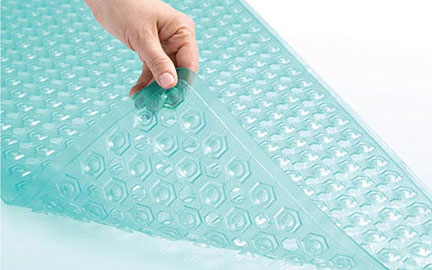
by mobilityplus | 10th Aug, 2023 | Accessibility
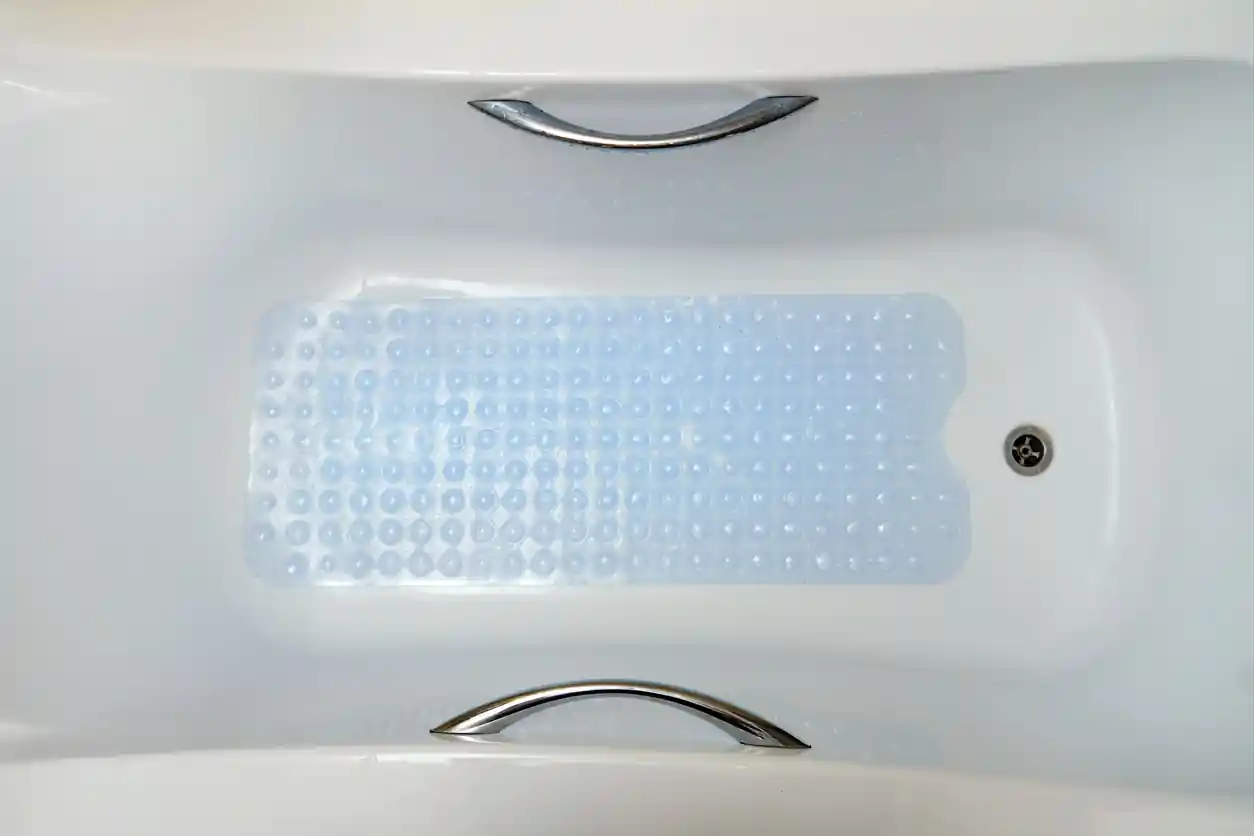
In 2008, it was estimated by the Centre of Disease Control that around 21.8m people in the United States would have a non-fatal fall in the bathroom. While this research isn’t the most up-to-date, it does give an indicator of just how many people have falls in the bathroom each year. Trends have also not changed drastically around the type of bathrooms people use, so it’s likely that these statistics are still very much representative of the situation people face when bathing.
While these falls are more manageable during younger years, once we enter the later period of our lives, these falls can become severe and even dangerous. Older people are also more likely to have falls, due to a combination of factors, including balance problems, muscle weakness, and poor vision. Long-term health conditions can also be factors.
In the UK, falls for people over the age of 75 are actually the most common cause of injury-related deaths, according to the NHS. Therefore, it’s absolutely essential that people are aware of the situation, and that we reduce the risk of falls where possible – including in the bathroom.
Request a Free Brochure
Simply fill out a quick form and see how we can transform the way you bathe.
Request Free Brochure
- Slip-resistant wet room flooring – the alternative to anti-slip bathroom mats
- Can I get slip-resistant built into my bath?
- What’s the alternative?
- Pairing anti-slip mats with other mobility bathing adaptions
- What are my options?
Slip-resistant wet room flooring – the alternative to anti-slip bathroom mats
One of the best ways to reduce the risk of falls, not using an anti-slip mat, is by using slip-resistant materials in surfaces that get wet. For example, if you have a wet room, always get this installed with slip-resistant wet room flooring (vinyl or tiled). Specially made surfaces are designed to help you get more grip on the flooring, even when wet. Slip-resistant flooring can be designed in a variety of ways. This can be done through acid etching, slip-resistant coatings, and other methods. Make sure you only use flooring that Is recommended for this specific use.
Can I get slip-resistant built into my bath?
Often, many bathroom companies will use slip-resistant materials when constructing bathroom products, as there is a higher risk of falls. As slip-resistant surfaces in the bathroom are so important for everyone’s safety, not just the less mobile or elderly, they are regularly used as a base for baths and shower trays. For example, our modern walk-in bath features a slip-resistant base, to help prevent falls that might occur when entering or exiting the bathtub.
What’s the alternative?
The alternative, cheaper option, is to get an anti-slip bathmat for your shower or bath. These are typically made from rubber, with suction cups on the bottom, that help you grip to the bath or shower floor and prevent slipping. Many people consider anti-slip bathmats to be a bit of an eyesore. Many are not stylish and ruin the aesthetics of their bathroom. However, they are chosen for practicality and not for their looks.
However, when it comes to anti-slip bathmats, there are things to look out for. The ant-slip bathmats can quite easily collect dirt, grime and be difficult to keep clean in your bathroom. After a few months, this will not come off, resulting in a permanently dirty bath mat. This can create something that is unclean and unhygienic. Bath mats can also become loose, making them a trip hazard If not properly secured. Make sure you check the fitting regularly.
Pairing anti-slip mats with other mobility bathing adaptions
Anti-slip mats on their own do not necessarily mean your bathroom is completely safe, as anti-slip mats do not account for people with mobility disabilities or in the cases of the elderly the difficulty of moving in general. However, other mobility bathing adaptions can help. Grab rails are one of the most common and best adaptions that can be added to a walk-in shower or walk-in bath, as they assist you in getting in and out of the shower or bath.
Pairing both will significantly reduce or even make it near impossible for any accidents to happen when doing your daily routine in a bathroom.
What are my options?
If you need a simple, quick fix, then an ant-slip bathmat is certainly an option. However, we would always suggest a more permanent solution if in the position to do so. Getting a walk-in bath or walk-in shower with slip-resistant flooring will always be a great long-term solution for bathroom safety, but also means your bathroom retains its natural style, uninterrupted by any mats that may not suit it.
If you have any questions about our slip-resistant flooring and products, give us a call and we’ll be happy to go through any questions you have.








